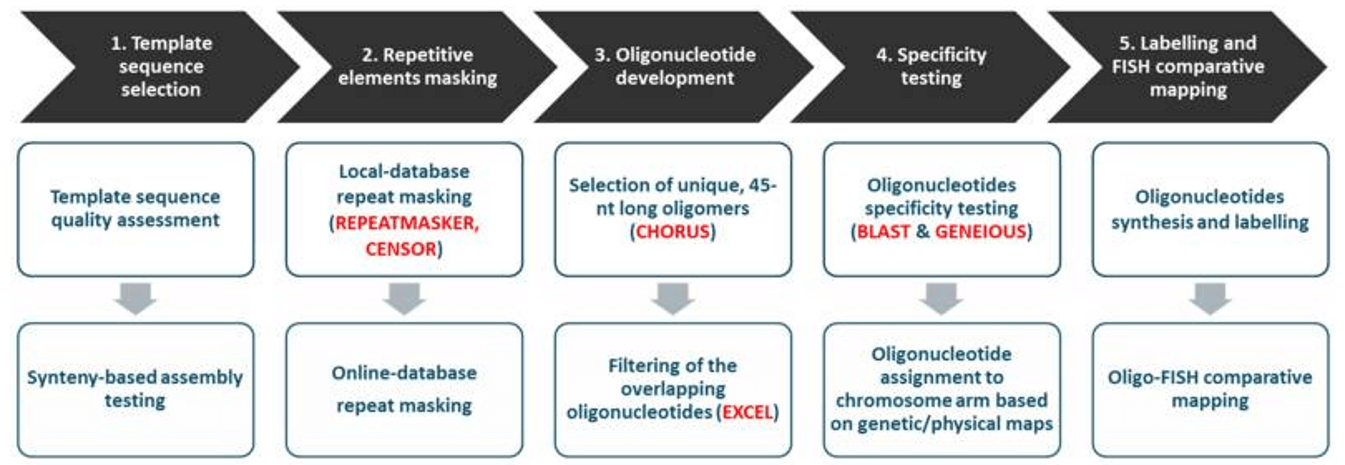Oligo-FISH Service
Creative Bioarray has many project experience in oligonucleotide probe development, synthesis, and fluorescence in situ hybridization (FISH) testing using oligonucleotide probes. Our DNA FISH experimental platform can successfully provide one-stop analysis and testing services from probe construction to providing data reports that can be used for publication. Our Oligo probe design is completed by scientists with rich experimental experience, providing you with the perfect solution for DNA FISH. We have established a mature program and can provide you with experimental program design and result analysis reports according to your requirements.
Oligonucleotide Probes and High-definition FISH
As the demand for molecular technology resolution grows, FISH technology is also developing in the direction of higher definition. The earliest FISH probe developed was a method based on a bacterial artificial chromosome (BAC) library. Traditional DNA FISH probes are produced by cloning the chromosome fragments of interest into BAC and then labeling them with fluorescent dyes. In contrast, this method has certain limitations and is not a master key. For example, this method takes a relatively long time. Another limitation is the relatively large size spanned by BAC probes (the size of custom-made FISH probes using BAC technology is limited to approximately 150 kb or more), which excludes the visualization of DNA sites that are only a few thousand bases in size. To overcome these limitations, DNA FISH probes composed of chemically synthesized oligonucleotides (oligos) were introduced and proved capable of high-resolution detection of genomic sites spanning only a few kilobases (kb). High-definition DNA FISH (HD-FISH) has gradually developed, which is a method of producing DNA FISH probes by double-stranded DNA amplicons generated by PCR. Synthetic oligonucleotides can be end-labeled with biotin-dUTP or digoxigenin-dUTP, or combined with fluorescent dyes during synthesis. There are some open-source FISH probe repositories, such as iFISH.
 Fig 1. General scheme of oligonucleotide-based probe development. (Bielski W, et al. 2020)
Fig 1. General scheme of oligonucleotide-based probe development. (Bielski W, et al. 2020)
Oligo FISH Probe Customization
The success of FISH analysis based on Oligo probes largely depends on the quality of the probes. Good probe design and excellent product quality can get twice the result with half the effort. We provide analysis and testing services based on custom Oligo probes, this service includes optional probe customization. Our optional custom Oligo probe service process includes:
1. Choose copy number, separation or double fusion probe
2. Enter the target region as the gene or chromosome coordinates
3. Submit the proposed oligonucleotide probe design plan for the client
4. Choose the color of the dye
5. Submit an order or choose follow-up testing services
 Fig 2. Oligo probe customization service process.
Fig 2. Oligo probe customization service process.
Testing Services
Our Oligo-FISH service provides analysis and testing services based on our commercial probes and customized probe products. The service process includes sample reception and pre-processing, mitotic chromosome preparation, probe preparation, and microscopy and image processing. This service can help customers with experimental design. You can communicate with our experts about the experimental plan and customize the appropriate Oligo probe to complete the detection and analysis. The cycle of testing services starts with the receipt of samples and finally submits an online report.
 Fig 3. Brief procedure of Oligo-FISH.
Fig 3. Brief procedure of Oligo-FISH.
Creative Bioarray provides a variety of technical service options from gene editing to stable cell line construction to help our customers save costs. You will benefit from our technical expertise and complete platform, and work with you to find the best solution to meet your needs.
If you are interested in our FISH service using Oligo probes, please contact us for cooperation. We look forward to cooperating with you in the near future.
References
- Gelali E, Girelli G, Matsumoto M, et al. iFISH is a publically available resource enabling versatile DNA FISH to study genome architecture[J]. Nature communications, 2019, 10(1): 1-15.
- Bielski W, Książkiewicz M, Šimoníková D, et al. The Puzzling Fate of a Lupin Chromosome Revealed by Reciprocal Oligo-FISH and BAC-FISH Mapping[J]. Genes, 2020, 11(12): 1489.
All products and services on this website are only suitable for non-medical purposes.


 Fig 1. General scheme of oligonucleotide-based probe development. (Bielski W, et al. 2020)
Fig 1. General scheme of oligonucleotide-based probe development. (Bielski W, et al. 2020) Fig 2. Oligo probe customization service process.
Fig 2. Oligo probe customization service process. Fig 3. Brief procedure of Oligo-FISH.
Fig 3. Brief procedure of Oligo-FISH.


